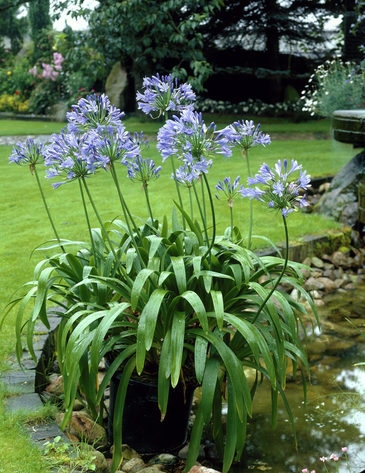Agapanthus Propagation: Tips for Expanding Your Plant Collection
Agapanthus Propagation: Tips for Expanding Your Plant Collection
Blog Article
Grasping the Art of Agapanthus Treatment: Important Actions for Healthy And Balanced Growth and Dynamic Flowers
In the world of cultivation, the farming of agapanthus stands as a gratifying venture for those who seek to support these classy blooming plants. From selecting the ideal selection to grasping trimming methods, the trip in the direction of growing prospering agapanthus plants is diverse and holds the essential to opening the complete capacity of these herb gems.

Choosing the Right Agapanthus Selection

When selecting the ideal Agapanthus range for your yard, take into consideration elements such as environment suitability, flower color, and development behavior. Agapanthus, commonly referred to as Lily of the Nile or African lily, comes in a range of colors ranging from shades of blue and purple to white. Choose a flower color that complements your existing yard scheme to create a harmonious landscape. Additionally, consider the climate in your region to ensure the Agapanthus variety you choose can grow in your details problems. Some ranges are a lot more forgiving of chilly temperatures, while others choose warmer climates. Recognizing the development routine of different Agapanthus varieties is important for appropriate placement within your garden. Some selections have a clumping development routine, suitable for containers or boundaries, while others have an even more dispersing nature, appropriate for ground cover or mass plantings. By very carefully evaluating these factors, you can select the perfect Agapanthus variety to enhance the elegance of your garden.
Suitable Growing Conditions
Taking into consideration the ideal ecological requirements is necessary for effective Agapanthus cultivation. Agapanthus plants are sensitive to chilly temperature levels and should be safeguarded from frost during winter season months.
To make sure healthy growth and vivid blooms, plant Agapanthus light bulbs at a deepness of concerning 2-4 inches and room them 8-12 inches apart. Adding raw material, such as garden compost, to the dirt can enhance water drainage and fertility, advertising robust root growth. Mulching around the base of the plants assists keep dampness and reduces weed development. Regular watering is essential, especially during the expanding period, to keep the dirt regularly moist but not soaked.
Watering and Feeding Tips
Maintaining appropriate wetness degrees and providing important nutrients are key aspects in the care regimen for Agapanthus plants. When it comes to watering Agapanthus, it is critical to strike a balance. These plants like continually wet soil but are at risk to root rot if overwatered.
Feeding Agapanthus is crucial for advertising healthy and balanced development and respected blossoms. Apply a balanced fertilizer, such as a 10-10-10 formula, in the very early springtime as new growth arises. By complying with these watering and feeding tips, you can guarantee your Agapanthus plants prosper and generate vibrant, news long-lasting blooms.
Trimming Strategies for Agapanthus
Pruning Agapanthus plants at the appropriate times and with correct strategies is vital for maintaining their wellness and promoting ideal development and flowering. The perfect time to trim Agapanthus is in late winter or very early spring before brand-new development arises.
For flowered stems, wait till the flowers have actually withered and after that trim them back to the base. This not just cleans up the plant's appearance but likewise encourages the advancement of brand-new blossom buds. Deadheading invested flowers can additionally reroute the plant's power into producing internet more flowers as opposed to setting seeds. Nonetheless, if you desire to collect seeds for proliferation, leave some flowers to completely dry and mature on the plant.
Remember to utilize tidy, sharp devices to make precise cuts and minimize the threat of introducing conditions. Agapanthus. Routine trimming will assist maintain your Agapanthus looking cool and healthy while guaranteeing a plentiful screen of gorgeous flowers
Managing Common Bugs and Illness
After ensuring proper pruning methods for Agapanthus, it is vital to deal with typical pests and illness that can affect the health and wellness and vigor of these plants. Agapanthus plants are normally hardy but can still come down with specific issues. One usual bug that influences Agapanthus is the Agapanthus gall midget. This little, orange fly lays its eggs in the vegetation, bring about distorted growth and flower buds that fall short to open. To combat this insect, prune and destroy any afflicted plant parts and think about utilizing insecticidal soap.
One more common issue is fungal leaf place, which provides as dark lesions on the leaves. To avoid fungal illness, guarantee excellent air blood circulation around the plants, prevent above watering, and get rid of see page any kind of infected fallen leaves promptly. In addition, Agapanthus plants can deal with root rot if they are planted in poorly draining pipes dirt. To prevent this, plant Agapanthus in well-draining soil and stay clear of overwatering. By being vigilant and taking prompt activity versus bugs and diseases, you can aid your Agapanthus plants prosper and produce vivid flowers.

Conclusion
Finally, grasping the art of agapanthus care includes choosing the right variety, offering suitable growing problems, proper watering and fertilizing, suitable pruning techniques, and dealing with usual pests and conditions. By adhering to these essential actions, you can guarantee healthy and balanced development and dynamic blooms for your agapanthus plants. Remember to frequently monitor and preserve your plants to promote their total health and durability.
To make sure healthy growth and dynamic blooms, plant Agapanthus light bulbs at a deepness of regarding 2-4 inches and space them 8-12 inches apart. By adhering to these watering and feeding ideas, you can guarantee your Agapanthus plants flourish and generate vivid, long-lasting blooms.
One common parasite that impacts Agapanthus is the Agapanthus gall midge. Furthermore, Agapanthus plants can endure from root rot if they are planted in inadequately draining pipes soil. By following these necessary steps, you can make sure healthy development and lively blooms for your agapanthus plants.
Report this page